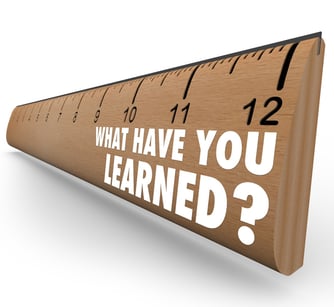Posted by Caveo Learning ● January 4, 2018
Learning Retention: Beyond the Classroom

In a recent blog, we pointed out strategies to increase learning retention by using what we know about human memory, but what about after the training event is over? How do we make sure it sticks?
In many organizations, learning is seen as a one-time event, often in a different location from the job site, and once it's over, the learning on that content is over. But in order to reinforce the application of the learning and identify the actual retention, we need to think of training as a continual process and extend it beyond the one event.
There are several practical ways to ensure knowledge transfer, and implementing these can improve the investment your organization has made in training employees.
Spacing, the phenomenon of reinforcing an idea or concept over time instead of all at once, is one of the key concepts in enhancing retention. A good place to start is by moving the final assessment out of the classroom and into the job site. Or if using eLearning, move the on-site assessment to the day after they complete the eLearning. Even just a day of spacing can both encourage the learner to remember what they learned and give an accurate representation of how much they've retained since yesterday. It seems simple, but it can be invaluable for measurement.
Another great way of measuring knowledge transfer is by engaging the manager of the learner. Too often, the manager sends the employee away to training (either in a classroom or at a computer) and does not follow up on the experience. Managers may be too busy to train their employees, but a manager should ensure the effectiveness of learning by extending the experience past the classroom. Give the manager a meeting planner or checklist of questions to ask the employee to measure how much they have learned. It is best if the manager uses this approach within a day or two of the training completion to continue the spacing.
Once the employee has been back at the job for a few days, it is time to measure retention further. There are several easy ways to do this:
- Provide another mini-assessment or a series of daily knowledge checks for a week. All of these can be tracked in the LMS if you'd like evidence of retention after the actual event, and many LMSs can be programmed to deliver these follow-up activities automatically at an interval after the training event.
- Establish a cohort of learners who were in the same class or who took the same training within the same week or month, and conduct a brief VILT or workshop to discuss what they learned and how they use it on the job. Add activities to the VILT to encourage participation in break-out sessions or discussions.
- Give the manager a short interview guide to use with the employee to spark discussion of what they learned and to record how they're using that information on the job. Provide a survey through the LMS or enable the manager to upload responses in the interview guide so that it's attached to the employee's learning records.
- Provide the manager or supervisor with an observation checklist if the training was about a procedure or set of tasks. Allow the manager to observe the employee performing the tasks learned during the training, and then upload the results/score to the LMS. Revisit the same checklist after some time has passed to see how the employee continues to progress with performing those tasks.
In order to maximize retention and performance, provide performance support tools from the LMS the day after the learning event. Ask the learner to find and download the performance support, which re-engages them with the learning and provides them an easy way to ensure they remember the learning.
By combining what we know about the brain with the power of your technology tools, you can improve retention for your learners, no matter how often they attend learning events. It just takes a little creativity and time to ensure the training sticks.
Brian Ziemba is a senior instructional designer with Caveo Learning. Based in Pittsburgh, Ziemba has over 10 years' experience designing and developing eLearning, instructor-led training, and performance support tools. Prior to joining Caveo, Ziemba worked as a performance consultant with IT firm Five Star Development. He holds an education degree from the University of Pittsburgh.
Topics: Metrics & Measurement, Instructional Design, Training and Facilitation

